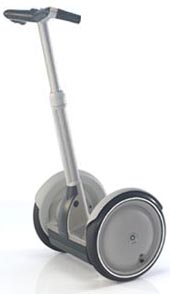
Segway will produce three distinct models: the i-series optimizes range and speed across a variety of terrain; the e-series is designed for business applications where it is necessary to carry cargo -- up to 75 pounds in addition to the rider; the p-series will be ideal for densely populated areas, both indoors and out. The Segway HT's footprint is narrower than the average adult's shoulders and its length is no greater than a large shoe. And it's quiet -- designed to emit only a barely audible harmonic hum.
Segway HT will first be introduced for commercial use. Initial applications include large scale manufacturing plants and warehousing operations, travel and tourism, public safety, corporate and campus transportation, mail, package and product delivery. Consumer availability is planned for late 2002.
Segway will soon begin evaluation with some of the world's leading corporations and service organizations.
United States Postal Service - Improved work environment; productivity enhancement
Michelin North America, Inc. - Easy R&D facility and plant navigation
GE Plastics - Potential improved worker productivity/proximity
National Park Service (NPS) - Increased Ranger mobility; environmentally friendly
City of Atlanta - Visitor education and improved (Ambassador program) community relations
Amazon.com - Distribution efficiency and improved logistics
According to Jack Hennessy, retired chairman of Credit Suisse First Boston Private Equity, "Dean is a uniquely talented engineer, passionate about using technology to solve important social problems. Human transportation is one of the biggest challenges facing cities around the world."
Kamen's team developed a breakthrough technology the company has termed "Dynamic Stabilization," which is the essence of the Segway HT. Dynamic Stabilization enables Segway's self-balancing emulation to work seamlessly with the body's movements. Gyroscopes and tilt sensors in the Segway HT monitor a user's center of gravity about 100 times a second. When a person leans slightly forward, the Segway HT moves forward. When leaning back, the Segway HT moves back.
"With over 80 percent of the world's population soon to be living in urban areas, we believe that the Segway HT can, over time, play a vital role in these areas," said Kamen. "In the past, every major advance in powered transportation technology has involved ways of going long distances faster from the horse and buggy to the car to the airplane. The Segway HT, on the other hand, addresses the problem of moving people and products relatively short distances more efficiently ... a few miles rather than from town to town using very little energy in the process."
December 3, 2001 - Industry-Leading Supply Partners Assembled to Develop Segway Human Transporter
The Segway Human Transporter (HT), the first dynamic self-balancing, electric-powered transportation machine, is the product of a groundbreaking group of leading technology partners. Segway HT is now being evaluated to see how it can help increase workplace productivity and efficiency by leading corporations and service organizations, including The U.S. Postal Service and Amazon.com
From computer hardware and software to rubber compounds and battery chargers, the Segway HT's component parts are the products of the most innovative experts in the transportation and technology fields. The technologies required to make the Segway HT possible include contributions from many leading companies, including Delphi Automotive Systems, GE Plastics, Michelin North America, Inc., Pacific Scientific, Saft and Silicon Sensing Systems.
"To bring a product like the Segway HT to market you need to have world-class supply partners with incredible vision -- and we've brought together just such a team," said Dean Kamen, Segway's chairman and the man with the technological vision behind the human transporter. "Each of these partners played a critical role in making the Segway Human Transporter possible."